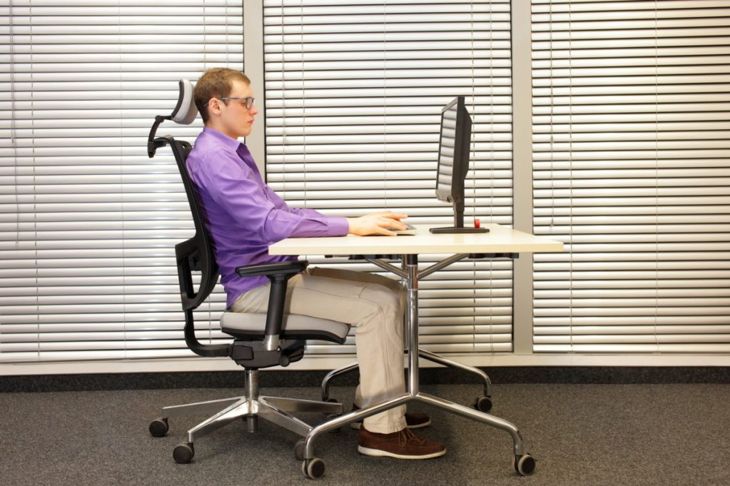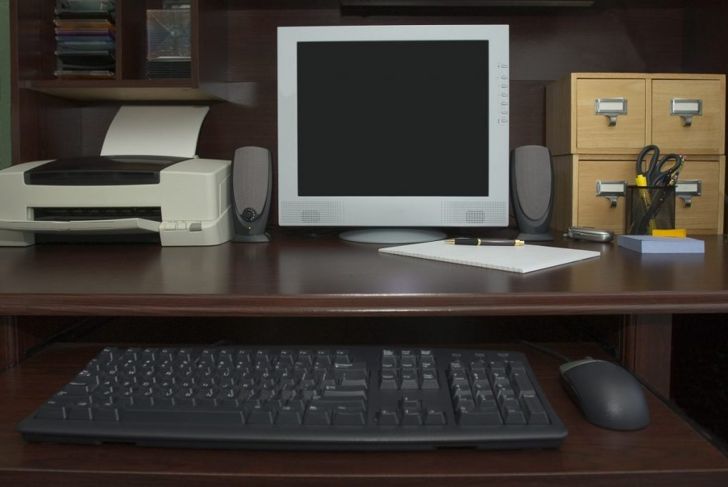If you work at home or in a coworking space, you may be wondering what the best way is to set up your workspace ergonomically. Ergonomic specialists take care of the details at large corporations, but it’s not hard to put together your own checklist and even do a decent job when you set up at a coffee shop. Your back, wrists, shoulders, neck, and eyes will all thank you for giving them a break from the stress of awkward workspaces. You’ll also find that you can stay focused and be more productive when your body is in proper alignment.
Desk Choice
The typical desk is about 30 inches high, but are you average sized? Make sure you have legroom when sitting and whether you are in a chair or standing, check that with your arms hanging straight down, you can bend to a right angle to write or type. In other words, pick a desk which comes up to your elbows. Standing or sit-to-stand desks can be great for those who have an active day or shouldn’t sit for long periods of time.
Ergonomic Chair
Ergonomic chairs are often quite expensive, but they provide significant benefits in adjustable support and comfort. Some people may find that they help with existing medical conditions while others may avoid back, neck and wrist issues by getting an ergo chair. It’s important to know how to make the many adjustments on the chair in order to benefit from it. A brief consultation with an ergonomics technician can be helpful to get started. Experts do not consider ball chairs as a good alternative to the real thing.
Chair Support Options
When you’re not at your desk, but instead are traveling, working at a coffee shop or coworking space, you can use specially designed lumbar and neck support pillows. These are often made with memory foam for luxurious comfort and firm, but compliant support. They’re also small enough to be carried. In some coworking spaces, though, ergonomic chairs are available so you might want to learn how to adjust them for your own needs.
Keyboard Position
Your keyboard should be located just above your lap so that your arms relax and droop just a bit from your elbows while you are typing. For your own desk, this can be accomplished with a keyboard drawer or shelf attached to the underside of your desk. Don’t forget to keep your feet flat on the floor and sit tall for best biomechanics.
Mouse or Trackball
Trackballs cost more, so most people use the mice that came with their computer. Your wrist will thank you for getting a trackball, especially if your work involves a lot of cursor movements, such as CAD designer jobs, graphic arts, and illustrator work. Using the trackball is fairly easy for most people, involving rolling the ball with one or two fingers instead of pushing the unit around, with clicking still similar. Trackpads have similar benefits, and they are also available separately and integrated with external keyboards.
Single or Dual Monitor Positioning
For monitor use, make sure you consult your vision care specialist if you wear lenses. A single monitor should be in front of you, arm’s length away (about 18-28 inches) and positioned so that your neck doesn’t have to bend for you to look at it. If you wear bifocals or similar lenses, place the monitor a bit lower so that it is in the proper range for your lens design. Basic dual-monitor setups should be balanced with edges touching directly in front of you and turned slightly towards each other. A swivel chair may help you use one or the other screen for longer times.
Lighting Choices
Lighting helps your eyes stay relaxed while you are working on the computer. You can combine overhead, desk and outdoor or ambient light to provide a low-contrast, natural background which doesn’t cause glare on the screen or your glasses if you use them. Use shades to adjust outdoor light. Don’t forget that you can adjust your screen’s brightness and contrast in the mix.
Graphic Arts Input Devices
Place input tablets and digitizers at about the same location as mice or trackballs, making sure that your arm is at 90 degrees or slightly more. Don’t forget to keep an eye your posture, as with keyboard work, as you may shift somewhat depending on how intensely you engage in the creative parts of your work.
Office Layout for Computer and Visitor
One computer-related factor which is often forgotten is the issue of frequent visitors. If you find yourself looking up from your keyboard or turning from your screen several times an hour or more, you may want to place your equipment and desk so that you can shift your eyes, not your neck or body, to greet visitors.
Video Conferencing, VR Headsets, Other New Options
Ergonomic choices for single-screen video conferencing, using stationary VR headsets or moving around and otherwise shifting your vision and attention in new ways is creating new challenges. Consider the basic principles of limiting body and eye fatigue, stress on joints by holding positions and by movement and positions with poor overall posture in using these new technologies.

 Home
Home Health
Health Diet & Nutrition
Diet & Nutrition Living Well
Living Well More
More




















